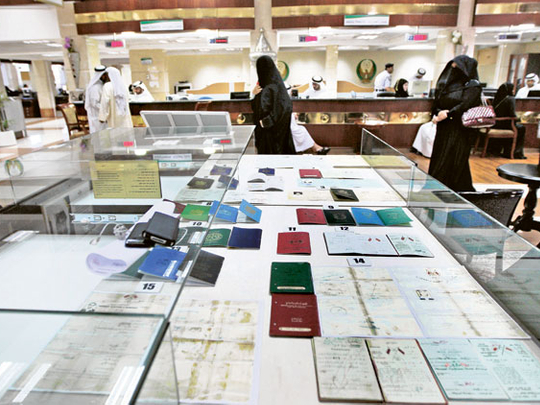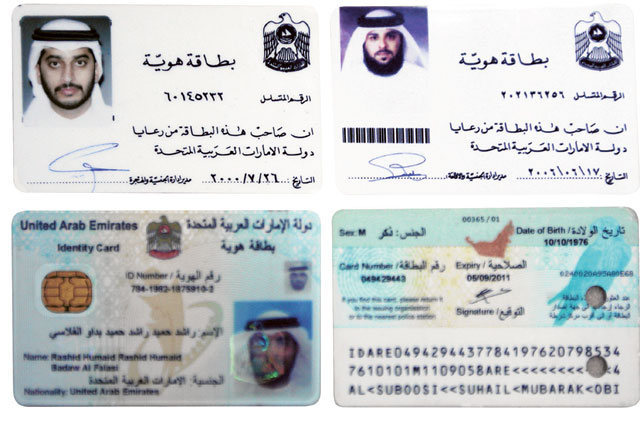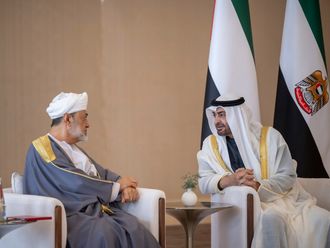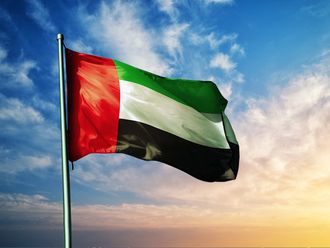
Dubai: History has a way of locking away the secrets of statecraft, but officials at the Naturalisation Department at the General Directorate for Residency and Foreigners Affairs (GDRFA) in Dubai are not letting it detract from their mission.
The department founded the Dana Historical Documents Museum late last year, looking to preserve the pre-confederation history of the emirate with the aid of travel documents from that era.
"Dana is a name that refers to Dubai. Dana is an Arabic name for the pearl," said Major General Mohammad Ahmad Al Merri, Director General of GDRFA.
The Dana Museum opened in December.
According to Colonel Ali Ganem Al Merri, adviser to GDRFA for naturalisation-related issues, the Dana Museum contains the "Dana documents", a group of historic documents related to ID cards, outpasses and passports.
"We want to show our young generation some features of our past which contributed to the formation of our present and it will definitely contribute to the future of our country," he said.
Colonel Al Merri said the Dana museum mainly exhibits Emirati travel documents and passports issued at the time of the former Trucial States.
"We have at the Dana museum a document as old as 53 years," he said. "This document is called the Trucial States Treaty and it is considered one of the oldest documents chronicling this phase. This treaty shows the close relationship between rulers and people of the UAE at the time even before the federation."
Story of the people
Colonel Al Merri said the Dana Museum is a critical repository because it tells the story of the people. "We are looking to collect more and more of such important documents from the citizens to enrich the museum. We want to show people the history of their homeland," he said.
"We want the new generation to know the important phases through which the country passed," he said highlighting the fact that awareness among the people is critical to fostering a sense of national identity.
He said the museum's collection includes a free out-pass issued in 1966 for travel outside the country. There is also a passport issued in 1973 and a family book.
"We can see from one of the historic passports that the holder of that passport did not put in the photo because she wore a hijab," Al Merri said.
In those times, people had the choice not to affix their photos on their identity or travel documents.
Al Merri said the museum's exhibits included passports and documents from all other emirates.
"Before the Federation, each one of the emirates used to have its own passports the same way they used to have their own flags, too. But after the Federation, the passports of all Emiratis all over the country became the same and they used to be black in colour," he recalled.
"People used to travel to the Gulf states, or to East Asia and some African coast to trade, and these travel [passes] used to be issued by the Customs Office in the Office of the Ruler at the time," Colonel Al Merri said.
Colonel Al Merri said that in the early 1980s authorities used to issue to citizens a family book which was separate from passports that had to be renewed every two years. The black passports were later given blue covers with their renewal due every five years.
Colonel Al Merri said the museum is open throughout the year and will welcome any authentic documents from the public that will boost its collection.
According to Colonel Ahmad Mohammad Al Muhairi, director of the Nationality Department, it is vital to document the country's history amid its rapid development. "We are giving the new generation the opportunity to be part of their history and know about production of documents and data in the past," he said.
Sweeping change
Al Muhairi said there was a passport in Dubai at the beginning of the early 1950s which was of a single page and listed the name, facial features, date of birth, purpose of travel ranging from business to study and the period of validity. Most passports were issued for six months or up to a year.
In Dubai, passports were once signed by the late Shaikh Rashid Bin Saeed Al Maktoum.
According to Lieutenant Rashid Al Falasi, who is in charge of the museum, a single-sheet passport issued in 1956 in Dubai was converted to a passport and went from one sheet to a small red book, the colour of the Dubai flag at that time. The passport carried on its cover the slogan ‘The Government of Dubai and its area' and it mentioned the passport number, passport holder's name, profession, eye colour, hair colour and special features.
Passports of women at the time simply used the word ‘veiled' with no explanation of their features at all.
From 1972 to 1994, UAE passports had a black cover which has since become blue. Last Dec-ember, the UAE issued the new e-passport which carries an electronic chip on the last page that enables the holder to enter and exit via land and airports.











